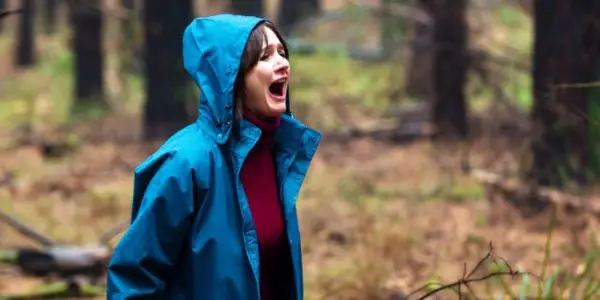Horror movies throughout history have been a horrific depiction of something deeper in society, a horror hidden behind creatures, monsters, and killers. While not all fall under this category, you can find them throughout the history of the genre. The disfigured faces that littered films of the 1920s speaks to the disfigured veterans returning from World War I. Serial killers attacking and killing those teenagers who had engaged in drugs and premarital sex. The oppression of the black community brought to life through the terrifying mental oppression of Get Out.
From writer and director Natalie Erika James, and led by a strong predominately female cast, Relic is the latest to tackle a present day issue, interweaving it through the delightfully horrific genre that not only entertains but informs. Yet, where many films have a tangible personification of the ills at its core, Relic relies primarily on the invisible. An unseen force that not only takes hold, but it also can not be fought, the evidence of its existence only witnessed in the increasing deterioration of its victims. Relic, through a deliciously brilliant depiction, personifies and tackles the social and familial issues surrounding dementia.
Relic
Relic‘s opening is quietly ominous and just as mysterious. As a bathtub overflows, its soapy liquid saturating the walls and creeping down the stairs, viewers are led quietly to an older woman standing in a doorframe entranced by the blinking lights on her Christmas tree. As the lights blink rhythmically, their festive color pulsating off the walls, there is an echo of a heartbeat pumping throughout the house. As the woman continues to stand in the entrance, unmoving, the heartbeat around her pulsating, it is as though she is trapped between two locations, unable to go back, yet unable to move forward.

Viewers are left with little explanation as they are introduced to the old woman’s daughter and granddaughter. Having received a call that no one had seen Edna in a few days (Robyn Nevin), Kay (Emily Mortimer) and her daughter Sam (Bella Heathcote) make their way to her home in the woods, unsure of what they are to discover. Coupled by a disturbing call Kay had received from Edna weeks earlier that she feared someone was in the house, the prospect of what they will find is daunting.
As they arrive at Edna’s, there is a deeply nuanced mise en scène that welcomes the characters and the audience. Little is spoken between Kay and Sam, yet the home they walk into paints a clear picture of the mental deterioration Edna has been experiencing. Post-its with reminders litter the home, chairs turned in a peculiar fashion, fruit rotting in a bowl, and dog food left out for a dog that is no longer there. A picture is quickly painted in the minds of the characters and the audience that Enda may be worse off than imagined, and as time passes on, her disappearance seems that more troubling.
Thankfully, Relic does not keep viewers in the dark regarding Edna for long, her disappearance a continuing mystery, yet her return not without its own concerns. Kay grapples with the understanding of how far her mother’s dementia has deteriorated, facing the grave reality that her mother may no longer be able to care for herself any longer or live alone. As she and Sam struggle to understand the best course of action for Edna, mysterious happenings in the house only compound the fears they each are experiencing.
Dementia And The Ties That Bind
Relic is a deeply nuanced film, the details of the home and depth of characters painting the picture of a woman slipping away into dementia. It is also a film whose nuances strengthen the imagery the film is attempting to execute. Opaque screens create a blurred and skewed view of Kate, while black mold seen constantly throughout the house spreads ominously, almost seeping through the cracks in the foundation and the windows. There is a sense of claustrophobia that exudes from the nuanced set and imagery, one that seems to press in not only on Edna but Kay and Sam as well.
Where Relic succeeds in its depiction of dementia, it also finds success in the deepest roots of familial ties. Where on the surface Edna, Kay, and Sam seem to have drifted apart as a family, there are moments and scenes where viewers come to understand that they have never been closer. That the times that bind run deeper than visitations and phone calls – at times, even deeper than blood.
As the house creaks, lights turn off, and on and furniture moves, there is a sense that at any moment this invisible force will take form, jumping out of the shadows to claim its victims. It will unrelentingly grip your attention until the final moments of the film, slowly loosening as you come to understand what it was all about. Relic brings everything full circle by its conclusion, giving a sense of satisfaction and understanding.
Conclusion
It’s hard to continue on too much regarding Relic without not only spoiling the twist and turns of the film but also robbing viewers of the power of discovery and understanding. What I can say is Relic is one of the knock-out horror films of the year. It is relevant and vital to an understanding regarding dementia, from a multitude of perspectives. This is a film that not only horror fans will enjoy, and everyone should see.
Have you seen Relic? What did you think? Let us know in the comments below!
Relic will be available on VOD on July 10, 2020.
Watch Relic
Does content like this matter to you?
Become a Member and support film journalism. Unlock access to all of Film Inquiry`s great articles. Join a community of like-minded readers who are passionate about cinema - get access to our private members Network, give back to independent filmmakers, and more.